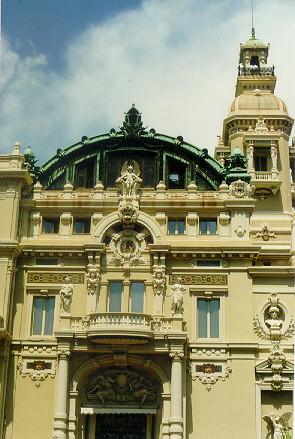Trio I (1972)
For Violin, Cello and Piano
1972 Prix de Composition Prince Pierre de Monaco
Duration: 15 minutes
The work is performed from full score.
Photocopies of composer’s manuscript available for sale.
Premiere Performance: April, 1972, Salle Garnier, Monte Carlo;
Members of Quintette Pro Arte:
Laurent Biancheri, piano; Jean Rey, violin;
Alain Lambert, cello
Salle Garnier, Monte Carlo
Trio I was Rodríguez’ first project when he began his musical studies with Nadia Boulanger in Fontainebleau in 1969. The work is in three movements (slow, fast, slow), each in a traditional ternary form (variations, sonata-allegro and rondo). The pitch material is drawn from one symmetrical four-note chord (E-flat, D, G, F-sharp), spaced as interlocking thirds. The dramatic climax in the second movement leads to the final adagio (rondo), which achieves a tranquil quality of suspended time as repeated pianissimo arpeggiations of the tonic chord gradually envelop the movement.
Reviews:
…A stunner. Heavy stuff. Tightly packed, busy, serious, earnest music. Without wastage or frivolity… A long-lined, though temporally brief work, it uses fully and authoritatively the many sound resources of a piano trio. And leaves the listener feeling he has heard an important statement from an important new voice. Daniel Cariaga, Los Angeles Times
…music which moves on two separate planes of sound and expression. In fact, the work might better be called a duality for piano and string, and, at times, even a duel. Long elegiac lines for violin and cello are challenged and punctuated by sharp, disjunct piano figures, almost as if two personalities were extemporizing on different subjects at the same time. Only toward the very end is a common ground sought and found…wears well on rehearing… I was struck this time around by the strong romantic and rhapsodic cast of the piece, despite the frequent starkness of its fabric.
John Ardoin, Dallas Morning News
Like many composers of his generation, Rodriguez began his creative life steeped in the gestures of modernism and expressionism, and the two early works…Trio I of 1971 and Trio II of 1970, present this “historical” face. The dates aren’t a mistake. Rodriguez was studying with Nadia Boulanger, and she asked him to stop the composition of his first trio momentarily to write a brief piece for the same forces, partly to focus his ideas and energy. It worked, according to the composer. The pieces are cut from similar cloth, though the First is expansive and intense, sometimes racing desperately, while ending in a still point of delicate repetitions. Berg seems a referent. The Second is more concentrated and, to my ear, seems very much from the world of the Schoenberg Op. 11 piano pieces, the “birth” of expressionism.
Robert Carl, Fanfare